Setting Up a Professional Radio Studio; What You Need to Know

Now that you've established your projection, you may want to get down to business and broadcast live on your Internet radio station. But which equipment should you choose between the multitude of choices out in that location?
In this course, we will larn the nuts of radio broadcasting, how to choose your equipment according to your needs and how to set your radio studio.
At the stop of this course, you lot'll be able to:
- Understand live broadcasting on the Cyberspace
- Choose the correct equipment to broadcast live
- Prepare upwardly a home radio studio
 Understanding live broadcasting
Understanding live broadcasting
Before diving into the deep end, it's interesting to understand how alive broadcasting works.
Live broadcasting, how does information technology work?
On an Net radio station you can circulate in two different ways: automatic style and live. When you create your playlists and schedule them to play, it's automatic. To carry out a live broadcast on the Internet from your Net radio station you must use a broadcasting software.
A dissemination software is a program installed on your computer. This calculator will need to be connected to the Internet in society to broadcast your show to the earth. It's through this connexion that you will be able to send your vox and music to the server that will frontwards your live feed to your listeners, regardless of the device they employ to listen to you.
![]()
Think:It'southward quite normal for in that location to exist a delay of effectually 45 seconds when going alive, this is the time taken for united states to receive the stream, process information technology, re-encode information technology then ship it to your listeners.The delay can vary between five and thirty seconds.
How to cull the right equipment for my needs?
All projects are unique and the ways to carry out a live circulate are also unique. It is important to decide your needs in order to create the studio that suits you. Before y'all start buying, it is essential that are able to answer these questions:
- Why are you going to circulate live?
- When are you going to broadcast live?
- Under which conditions? (Outside, on the move…)
- Volition in that location be other hosts? If so, how many?
- Do you have a dedicated space for your live broadcasts? A studio?
- What is your budget?
If you have read the first part of this grade, you lot already know that y'all can do a live circulate with a computer and dissemination software. In theory, by using your estimator's internal microphone you could quite easily perform a alive broadcast. But if you're looking for more than professional atmospheric condition and sound, you volition need to add a microphone.
Your microphone must be connected to your computer, generally a mixer (as well known every bit a mixing desk or mixing table) is used for this purpose. If you are alone or recording in outdoor conditions, you may prefer a more than mobile audio interface.
The mixer allows y'all to connect and manage several sources at the same time (microphone, telephone, headphones…). Finally, to achieve a alive circulate worthy of radio conditions, yous will need a headset for your feedback. Feedback is when yous hear your interventions, those of your hosts and the music directly in your ears through your headphones.
PLUS: Don't forget the cables that y'all will need to connect your equipment.
- XLR cables to connect your microphone to your mixer (or interface)
- Stereo Jack cable
- A Jack to Jack Cable / RCA to RCA Cable

 Choosing the equipment for your radio studio
Choosing the equipment for your radio studio
We take prepared a option of the unlike equipment for you, only, as we accept already said, there is no such thing equally a good microphone or mixer. The appropriate equipment will exist the 1 that is adjusted to your needs. If you have the opportunity, practise not hesitate to test information technology before purchasing.
Choosing your live broadcasting software
Now, which dissemination software to choose? Information technology tin be difficult to come across clearly considering there are so many of them. Feel free to test several of them in order to see the different functionalities of each one. Ask yourself why yous are going to do live broadcasts. Retransmit a concert? Do an interview? Mixing music? Not all software is necessarily adapted to your project. Add to that the fact that you will not have access to the same software whether yous are on Mac, Windows or Linux. Here is a small-scale listing of broadcasting software to help you see more than clearly.
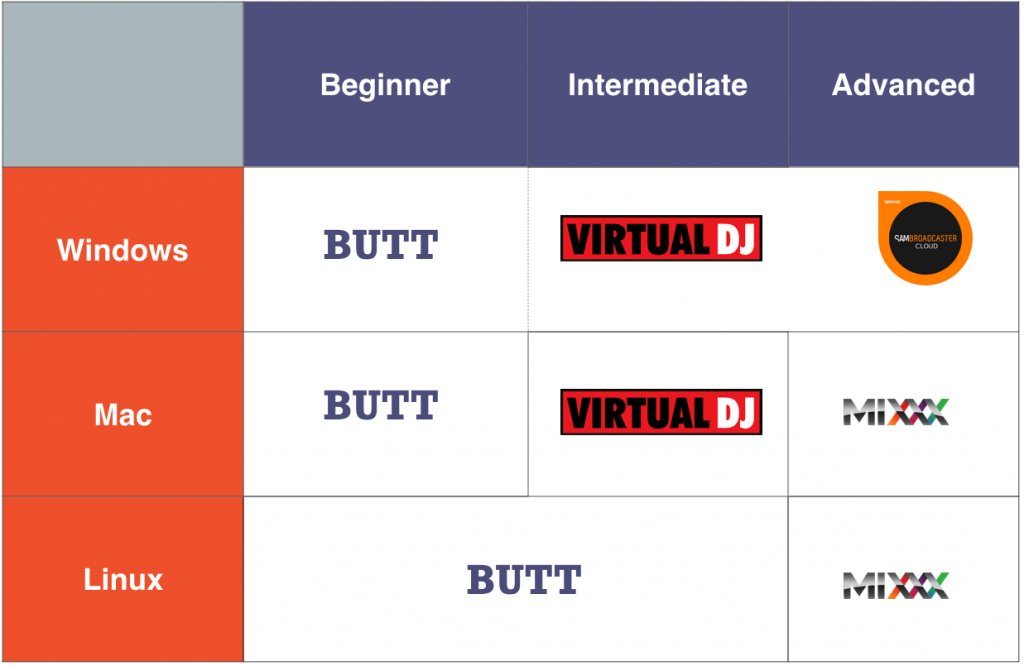
BUTT:Barrel stands for Circulate Using This Tool. It's a small open up source software for all operating systems. If its simplistic attribute can put some people off, information technology is one of the best allies for Internet radio stations. It is even used by FM stations to retransmit their streams.
Virtual DJ Pro: (Window and Mac). If you want to play a lot of music and y'all have a lot of songs in your folders, Virtual DJ may be right for you. Information technology will toll you $299 to become the total version, although you lot can examination the limited gratuitous version.
Sam Broadcaster: (Windows). It's an automation software so it may seem complicated at first glance, but it is one of the most avant-garde software. If the trial is costless, you can count betwixt $fifteen and $130/ month to larn the software in its entirety.
Mixxx: (Windows, Mac and Linux). Suitable for all operating systems Mixxx offers a very high degree of customization. Unfortunately, the software can seem very complicated for beginners. However, it's worth it and to avoid ruining anything, it's costless!
What if I want to broadcast live from my smartphone? Note that in that location are very few dissemination software bachelor for smartphones, or iPads. There are two of them: iCast ii for iPhone (for a fee) and Mediacast for Android (costless).
Choosing a microphone for your Cyberspace radio station
The world of microphones is very vast, there are a multitude of models and a very wide range of prices (from $10 to more than $2000). To assistance brand your choice there are several criteria to accept into business relationship:
Directivity: This refers to the sensitivity of the microphone and its ability to pick upwards the source of the sound. At that place are several types of directivity. Ominidrectional (the microphone picks up sounds from all directions, interesting for some recordings, just not recommended for radio). You may want to opt for a cardioid microphone that will but choice upward the source in front of the microphone.
How it works: Sensitivity and rendering will depend on how information technology works: some produce a "warmer" sound (condenser microphones), others are more resistant (dynamic microphones).
Connectedness: It is recommended to larn a microphone with an XLR connectedness so that you lot can connect your microphone to a mixer. But if you are alone, a USB microphone that you can connect directly to your reckoner can also be a wise investment.
Bear in listen that that condenser microphones require an external ability source (phantom power) to operate.
In full general, nosotros propose you to invest in a dynamic microphone with a cardioid pick up blueprint.
Here is a selection of microphones according to budget.
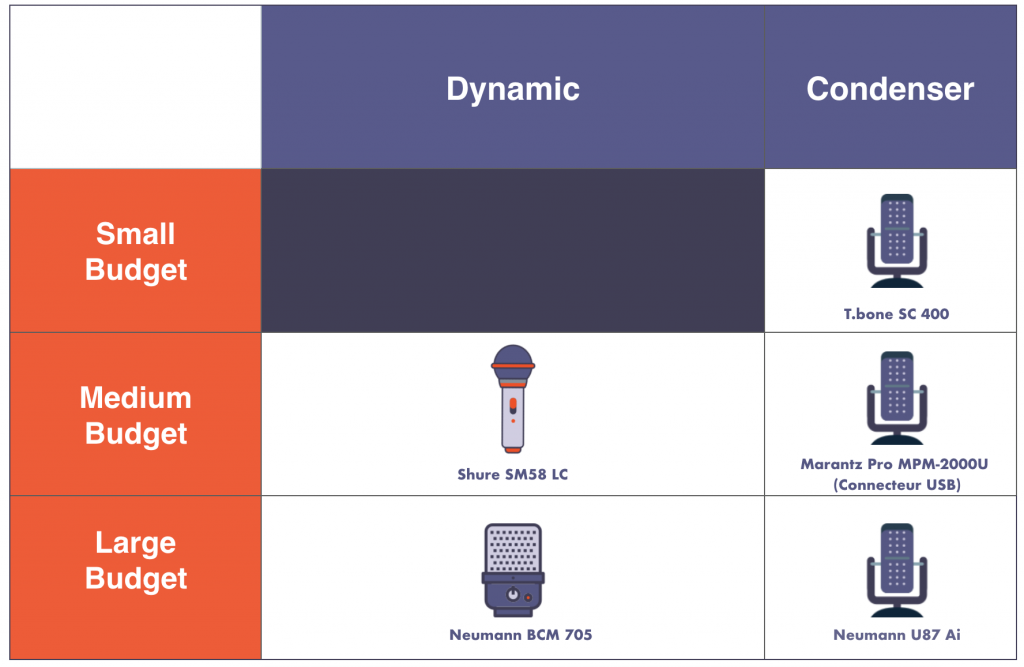
Choosing your mixer
A mixer will allow you lot to connect all your devices (inputs) and send them to the dissemination system. You volition be able to manage these entries independently. A mixer tin be digital (more expensive, only which allows you to procedure the sound beforehand also as save your settings) or analog. A mixer has several strips depending on its size. A strip corresponds to a source.
When choosing your mixer, be careful to accept into business relationship the number of inputs. How many devices do y'all desire to connect to your mixer? Be sure to check the number and type of inputs you want to connect before purchasing a model. Each input is dissimilar, so a microphone can be XLR (or USB) type, you may likewise need a jack, USB etc.
Conscientious: Also consider buying a USB interface to connect your mixer to your computer.
Here is a choice of mixers co-ordinate to your budget and the number of inputs:
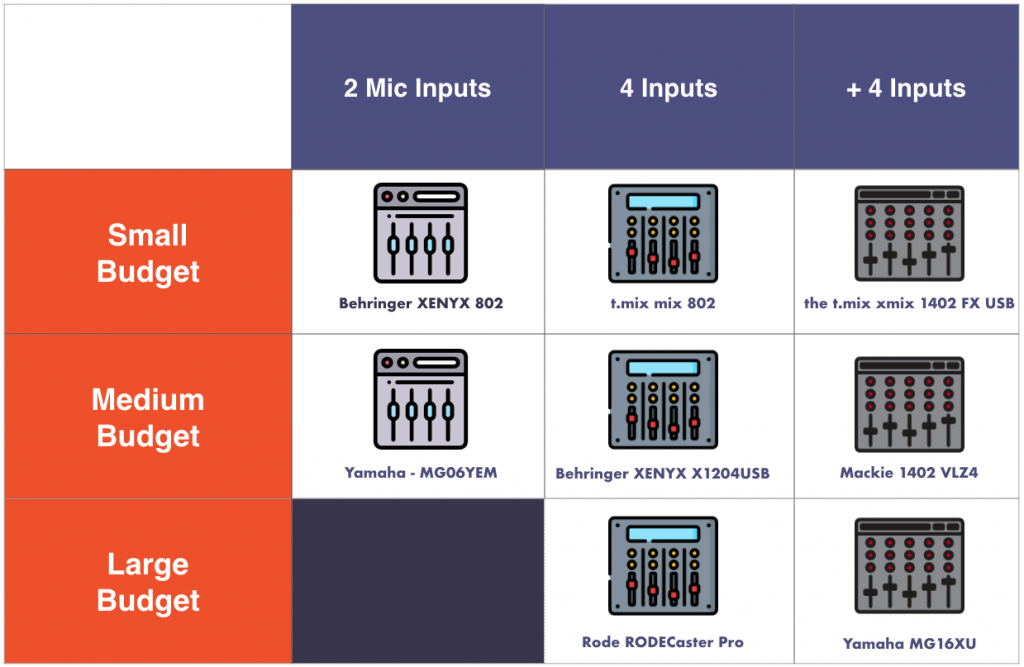
If y'all don't want to invest in a mixer or if you want to exist mobile while enjoying a microphone, the iRig Pre could exist a good alternative.
Finally, the last essential element for your radio studio: an sound headset. Don't fail the search for proficient headphones, it's an important point for a radio host. Your headset will allow y'all to approximate the quality of your broadcast.
There are several things to remember when information technology comes to choosing the platonic headset for your radio.
Choosing open or airtight headphones: in that location are many debates on this discipline. Open up headphones allow a better sound reproduction, whereas closed headphones isolate you from your environment, therefore they allow ameliorate concentration during your shows.
Choosing comfy headphones: this must exist i of your top criteria, especially if you are doing long shows.
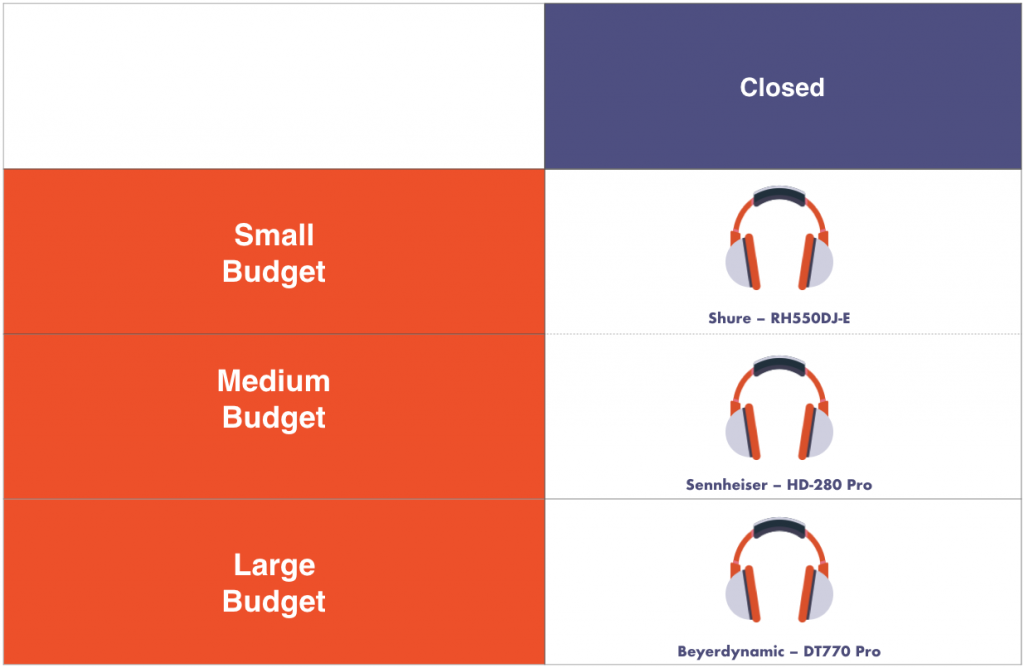
CAREFUL: For the fix of your radio studio, don't forget: a headphone amplifier, this volition permit yous to connect your headphones to your mixer.
 Setting up your Home Radio Studio
Setting up your Home Radio Studio
So, do you lot have all your equipment and are looking forward to your first live circulate? In that instance let's motility on to the adjacent step: setting upwards your radio studio.
First of all, in addition to a mixer, headphones and a microphone you will likewise need cables!
To connect your estimator to your mixer, you volition demand an RCA cable. You will too need a stereo jack cablevision to connect your headphone amplifier to your mixer. Finally, you will need as many XLR cables every bit microphones.
First, connect your microphones to your mixer. Then connect the amplifier to the mixer. Add the headphones to the amplifier. And finally, connect your computer with your broadcasting software to your mixer.
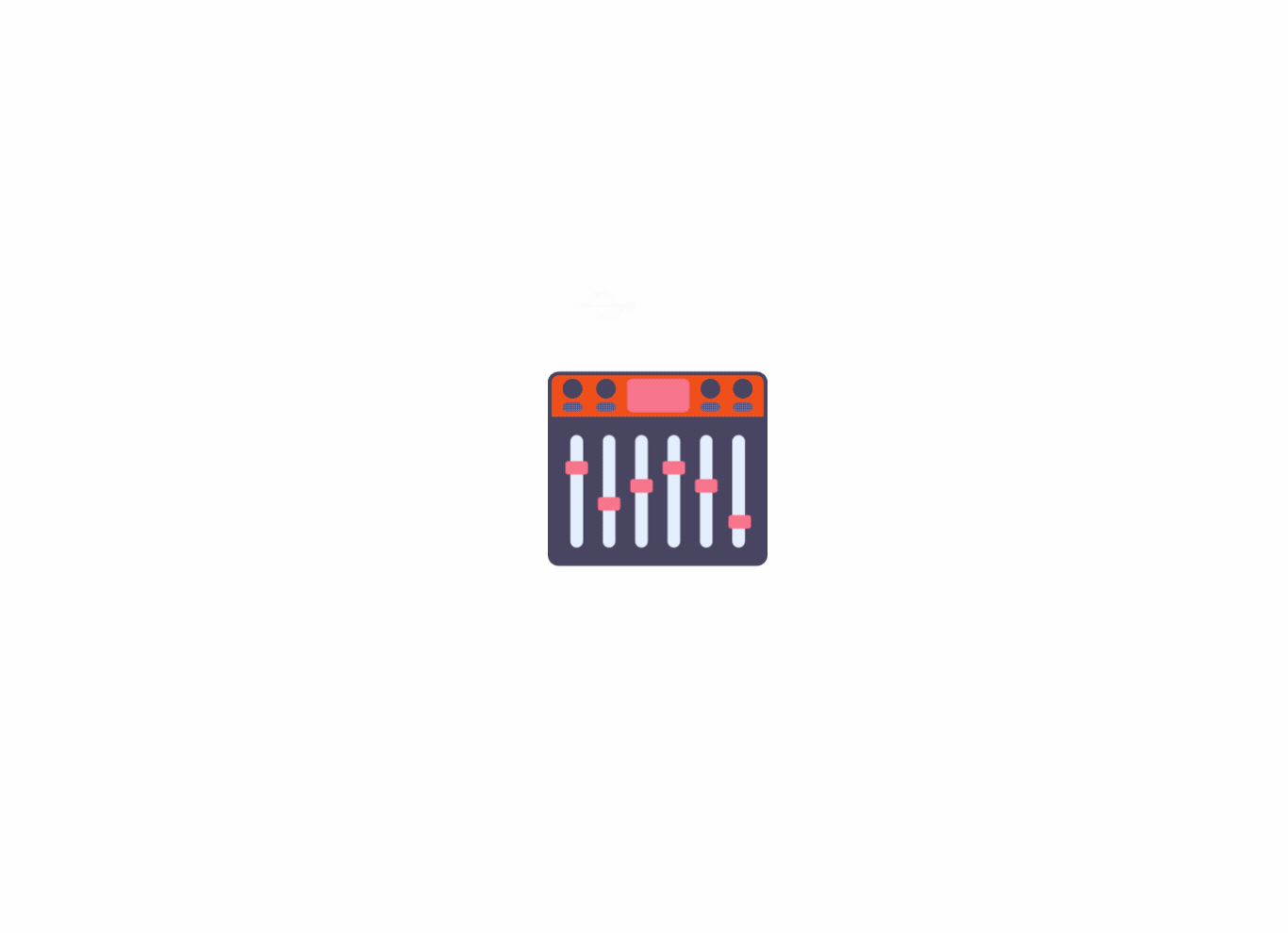 Don't forget your UBS interface so you tin connect the mixer to the computer.
Don't forget your UBS interface so you tin connect the mixer to the computer.
![]() TO SUM Upwards:
TO SUM Upwards:
- Earlier making any purchases, ask yourself what are your needs?
- If you can, attempt and test the equipment before purchasing
- Don't forget the cables and other necessary elements to connect your equipment (interface, amplifier, etc…)
We've reached the end of this second form, give thanks you for reading! We hope yous enjoyed this class and that it provided you lot with answers to your questions before starting your Cyberspace radio station. Yous can at present motion on to the adjacent class and detect your format and content… So go ahead!
Previous gradeNext grade
Set to create your own Net radio station?
Enjoy our free 7 day demo and create your radio easily with the Radio Managing director.
No commitment, you can cancel at any time.

Source: https://www.radioking.com/p/create-home-radio-studio/

0 Response to "Setting Up a Professional Radio Studio; What You Need to Know"
Post a Comment